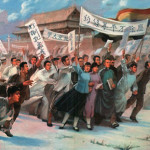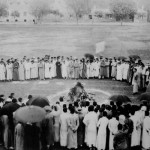
The May Fourth Movement was an intellectual and reformist movement that reached its peak in 1919. The movement was initiated mainly by university students, who were angry at China’s treatment at the hands of Western powers after World War I. Specifically, they were outraged by the passing of German imperial interests in Shandong province over to the Japanese. The May Fourth Movement was anti-imperialist and demanded the restoration of Chinese independence and sovereignty. Its leaders also wanted socio-political reform, namely the eradication of Confucian values and a society based on democratic government, liberal individualism, science and industry. The movement peaked on May 4th 1919, when thousands of students rallied in Beijing to protest against China’s treatment in the Treaty of Versailles. Their protest was supported by students and striking workers across China. These events radicalised political movements in China and contributed to the rise of groups like the Chinese Communist Party (CCP), which was formed two years later.
Reformist ideas and movements were not uncommon in late imperial China. The supporters of the Self Strengthening Movement of the 1800s endorsed limited economic and educational reforms. Kang Youwei, the main architect of the Hundred Days’ reforms of 1898, reinterpreted Confucianism to allow for political and social reform. The failure of the early republic and the descent into warlordism led intellectuals to examine the relationship between past and present in China. At the forefront of this was the New Culture Movement, a broad collection of scholars, writers and intellectuals, based mainly in Beijing and Shanghai. Beginning in the mid 1910s they argued that Confucianism and classical philosophy had little relevance or value in 20th century China. For China to survive and prosper, it had to adapt and embrace modern ideas and values.
The New Culture Movement launched withering attacks on Confucianism, which had sustained the Qing dynasty beyond its usefulness and reinforced outdated social values like hierarchy, paternalism, obedience and unquestioning respect. New Culture writers supported the introduction of Western social and political concepts and values, including democracy, republicanism, self determination, equality and individual liberties. But New Culture advocates recognised these things were not achievable without a significant cultural shift among the Chinese. There could never be a democratic China, they argued, while political authority was reinforced by Confucian teachings, while tradition consistently blocked progress and while patriarchal family structures impeded individual freedoms and the rights of women. Writing in 1916 a Beijing professor said:
“A constitutional republic cannot be conferred by the government, cannot be maintained by one party or one group, and certainly cannot be carried on the backs of a few dignitaries and influential elders. A constitutional republic that does not derive [its authority] from the … majority of the people is a bogus republic and bogus constitutionalism. It is political window-dressing, in no way like the republican constitutionalism of the countries of Europe and America, because there has been no change in the thought or the character of the people.”

The May Fourth Movement that erupted in 1919 was a show of youthful support for the New Culture Movement, as well as a surge of Chinese nationalism. It was triggered by the publication of the draft Treaty of Versailles, the peace agreement that formally ended World War I. Yuan Shikai’s government had supported the Allies in the war, on the condition that foreign spheres of influence in China be abolished. But by 1919 China had no effective national government, so Chinese negotiators in France found it difficult to push their claims. Chinese interests were consequently overlooked in the Versailles treaty, which handed Germany’s sphere of influence in Shandong over to the Japanese. Angered by China’s shoddy treatment in Paris, and encouraged and supported by many of their professors, radical students at Beijing University began to mobilise. They drafted a manifesto condemning the Versailles treaty and the government representatives who failed to prevent it:
“Japan’s demand for the possession of Qingdao and other rights in Shandong is now going to be acceded to in the Paris Peace Conference. Her diplomacy has secured a great victory – and ours has led to a great failure… This is the last chance for China in her life and death struggle. Today we swear two solemn oaths with all our fellow countrymen. First, China’s territory may be conquered, but it cannot be given away. Second, the Chinese people may be massacred but they will not surrender. Our country is about to be annihilated. Up, brethren!”

On May 4th 1919 students from Beijing University and 12 other schools and universities gathered in the capitol. They drafted resolutions calling for a mass uprising to oppose the Japanese occupation of Shandong. More than 3,000 protestors assembled in Tiananmen Square, chanting nationalist slogans and urging the Beiyang government not to ratify the Treaty of Versailles. The government responded by dispersing the protestors and arresting almost three dozen of its leaders. The following day Beijing students went on strike, an action quickly replicated by students in other parts of China. In early June up to 100,000 industrial workers in Shanghai declared a week-long general strike, angry at the government’s suppression of students in Beijing and the ongoing detention of student leaders. To the grievances of the students these striking workers added their own, demanding higher wages, better conditions and an end to exploitation. What began as a demonstration by students from one university had become a more expansive national movement involving students, organised labour and political groups. Tensions only eased after the government released student prisoners, sacked several key ministers and instructed its negotiators in Europe not to sign the Versailles treaty.
“May Fourth has become an extremely important but ambiguous notion in all discussions of modern Chinese history. The Communists have sometimes gone so far as to trace the origins of their Party to May Fourth – they saw May Fourth as representing progressive, patriotic elements, as marking the emergence of the working class and as leading to ‘cultural revolution’ – then they treated May Fourth as the necessary condition for the appearance of the CCP. The Nationalists held ambivalent feelings about May Fourth, but the more reformist elements of the GMD identified with its themes of ‘enlightenment’.”
Peter Gue Zarrow, historian
The May Fourth Movement consequently achieved many of its objectives, however it failed to halt the Japanese takeover of Shandong. The cultural and ideological effects of May Fourth proved more telling. Before the events of 1919, many Chinese reformists had placed their faith in Western models of government and the promises of Chinese independence and self determination made by Western political leaders – but these promises had been broken in Paris. The Treaty of Versailles demonstrated clearly that China could not wait for Western nations to guide it into modernity. China was responsible for its own political development and its own fate. As a consequence, the May Fourth Movement energised and radicalised Chinese political movements. The Chinese Communist Party traces its origins back to the tumultuous weeks of mid-1919. Several notable CCP leaders, including party founder Chen Duxiu and Mao Zedong himself, were involved in or affected by the May Fourth Movement.

1. The May Fourth Movement was a protest by thousands of students in May 1919, in response to China’s treatment in the Treaty of Versailles and the cession of Shandong to the Japanese.
2. The intellectual origins of this movement can be found in the New Culture Movement, a campaign of the 1910s that challenged the role of Confucianism and traditionalism in 20th century China.
3. The writers of the New Culture Movement argued that China could not modernise by clinging to Confucian values and old hierarchies. It had to embrace liberalism, democracy and science.
4. The May Fourth Movement of 1919 started as student protests against the terms of the Versailles treaty. It quickly expanded into a series of nationwide protests and strikes, leading to a backdown by the Beiyang government.
5. The New Culture and May Fourth Movements had a significant impact on Chinese political movements, which stopped looking for Western guidance and became more radical in their outlook and methods.
© Alpha History 2018-23. Content on this page may not be republished or distributed without permission. For more information please refer to our Terms of Use.
This page was written by Glenn Kucha and Jennifer Llewellyn. To reference this page, use the following citation:
G. Kucha & J. Llewellyn, “The May Fourth Movement”, Alpha History, accessed [today’s date], https://alphahistory.com/chineserevolution/may-fourth-movement/.
This website uses pinyin romanisations of Chinese words and names. Please refer to this page for more information.
